Abstract
The paper shows how Mind Genomics, coupled with AI, can drive the creation of messaging for a new cosmetic product. AI (ChatGPT 3.5) in the Idea Coach feature of BimiLeap.com, the Mind Genomics platform, generated the required 16 test elements for Mind Genomics. These test elements (statements about the product) were combined into vignettes, presented to 25 English respondents (ages 18-25). The data, collected in less than two hours through an online panel, identified strong performing elements and two dramatically different mind-sets among the respondents: those interested in the texture and skin-relevant aspects and those interested in the fragrance. The speed, low cost, simplicity, and scope of the research provides a new way to understand products, build the critical knowledge base and generate potentially better market entries.
Keywords
Artificial intelligence, Consumer behavior, Cosmetic product development, Market research innovation, Mind genomics
Introduction
Product development and marketing have traditionally relied on qualitative interviews or questionnaires to gather insights from consumers. The process required the respondent to think in an abstract way about experiences that are often concrete and hard to conceptualize. Thus, in a situation involving cosmetics, the respondent may be asked to rate the importance of ideas or experiences one at a time. It is not unusual for consumer researchers to report these ratings as the “truth” for a particular respondent [1-3]. The emergence of Mind Genomics thinking in the late 20th and early 21st centuries introduced a new approach. This approach involves breaking down a problem into different topics or questions and then identifying various answers or elements for each question. These elements are combined into vignettes, which are small, easy-to-read combinations that paint a word picture. Respondents do not answer individual questions but instead respond to the vignettes created by the combination of elements. This approach is simpler and more engaging for participants, as it allows them to provide feedback based on real-world scenarios rather than abstract concepts. The underlying statistical machinery then analyzes how each element contributes to the overall rating of the vignette [4-6].
Today’s version of the Mind Genomics process involves four questions, each with four answers or elements. These elements are stand-alone phrases or sentences that are mixed and matched into vignettes according to a predetermined experimental design. The experimental design ensures that the elements are statistically independent of each other, allowing for a more accurate analysis of consumer responses. One of the most important aspects of Mind Genomics is that each respondent evaluates just the right number of vignettes of the right construction by an underlying experimental design. The experimental design ensures that each vignette has a minimum of two elements and a maximum of four elements. Furthermore, in each vignette, the elements must come from different questions. That is, no question can contribute more than one element to a vignette, although there are, of course, many vignettes to which a question does not contribute. Perhaps the most important feature is that each respondent in the Mind Genomics study evaluates a unique set of 24 different vignettes. The underlying permutation scheme thus enables the Mind Genomics study to cover a wide range of combinations.
Finally, with the Mind Genomics platform, BimiLeap.com and the embedded artificial intelligence available through the Idea Coach feature, it becomes a very simple matter for the researcher, experienced or inexperienced, to develop questions and answers [7]. The benefits of this approach are that the Mind Genomics system becomes a way to explore the topic rather than to confirm one’s judgment. The old Russian adage “measure nine times, cut once” is not necessary. The user can freely explore the topic because it is not necessary to “know the right answer” at the start of the study or experiment. The answer emerges.
Setting Up the Mind Genomics Study to Understand How “Real People” Feel About Ideas for a Cosmetic Lotion
Step 1 requires the researcher to create four questions that “tell a story” and then for each question to create four separate answers, hopefully each answer meaningfully different from the other three answers to the question. Figure 1 shows the template where the researcher fills in the four questions. Figure 2 shows the template where the researcher fills in the answers to the first question.
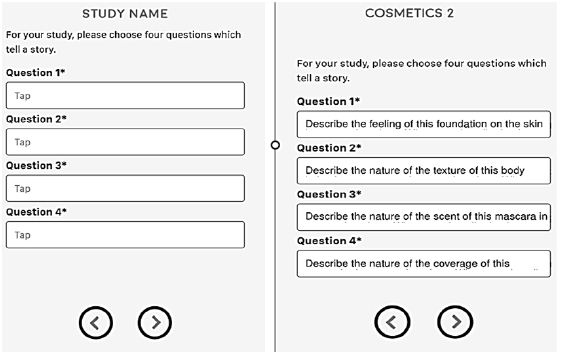
Figure 1: Template in BimiLeap.com requesting user to create four questions which tell a story.
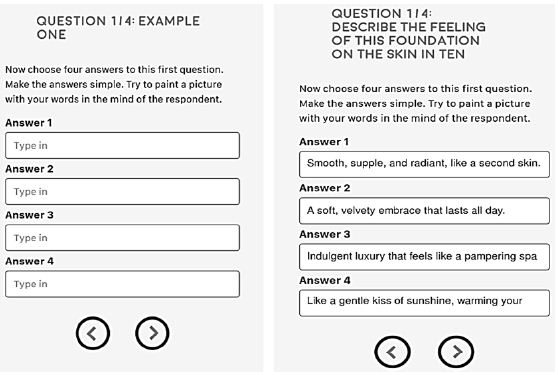
Figure 2: Template in BimiLeap.com requiring the researcher to create four answers to the question.
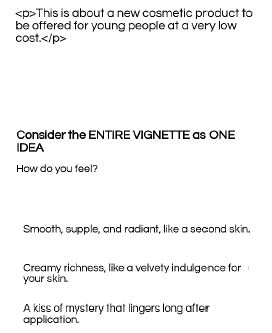
Figure 3: Example of a vignette with the rating question (top) and the actual vignette comprising three elements (bottom).
In the original Mind Genomics studies, researchers faced the challenging task of developing questions and answers for each topic. This task proved to be daunting for many individuals, especially older professionals, as it required critical and creative thinking skills that were not commonly taught. The concept of structuring thoughts into questions and answers forced participants to step out of their comfort zone and think outside the box. With the integration of AI into the BimiLeap.com platform through the Idea Coach, the process of generating questions and answers became more streamlined. Users could simply input the topic and some information, and the platform would generate 15 relevant questions. Researchers were then tasked with selecting up to four questions, completing one or several iterations, and fine-tuning the questions to create a narrative for the study. The same process is applied to generating answers, with AI creating responses based on the selected questions. Researchers were responsible for choosing and arranging the answers to create a coherent word picture that could stand alone or in a group. This innovative approach allowed for a more efficient and structured way of collecting data and insights from participants. For both generating questions and answers, the Idea Coach enabled the user to specify the nature of the way the questions and answers should “read,” e.g., be explanatory, have fewer than a certain number of words, etc. Furthermore, Idea Coach enabled the user to “edit” the output from AI at any time so that the Idea Coach became a true aid to the project, rather than “taking over.”
Table 1: The four questions and the four answers to each question, as created by AI and edited slightly by the researchers.
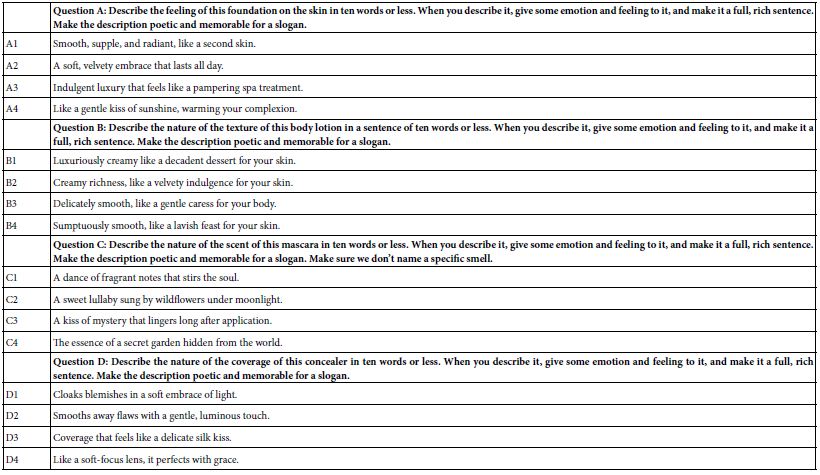
Table 2: Two preliminary self-profiling classification questions and the rating question.
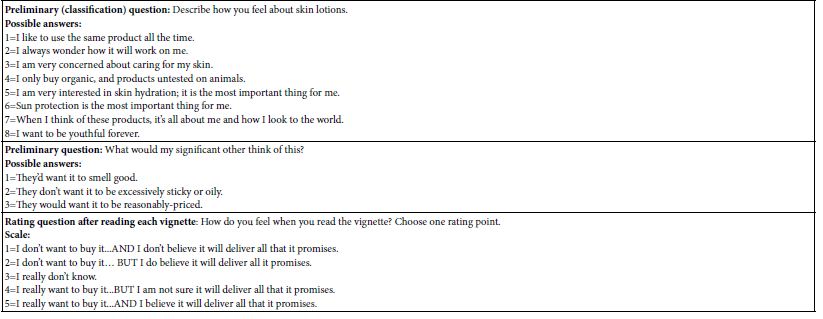
Incorporating AI into the research simplified the process of developing questions and answers, allowing researchers to focus more on the analysis and interpretation of data. This approach not only saved time and resources but also enhanced the overall quality of the elements, as Table 1 suggests. The elements “read well.”
The actual implementation of the study is straightforward, following these steps:
- The questions and elements (answers) are generated and put into a form so that each element becomes a stand-alone phrase that paints a word picture.
- The BimiLeap platform combines the elements into 24 combinations known as vignettes. Figure 3 (bottom) shows an example of the vignette, in this case three elements or answers, one element or answer from three of the four questions. The fourth question does not contribute to the vignette.
- The underlying experimental design prescribes 24 vignettes. The combinations are created in order to ensure that the 16 elements or answers appear equally often (5 times in 24 vignettes) and that no vignette contains more than one element or answer from a question (preventing mutually contradictory statements in a single vignette).
- The basic design is permuted to create “isomorphic” designs. That is, the mathematical structure of the 24 vignettes is maintained, but the elements are permuted. The happy result is that each respondent evaluates a unique set of combinations.
- Each respondent evaluated the appropriate 24 vignettes, making it possible to analyze the data from each separate individual.
- The permutation scheme is set up so that one need not know the “right combinations” to test. As noted in the introduction, this permutation means that the Mind Genomics procedure tests a great deal of the possible space. The analogy to this approach is the MRI, which takes pictures of the underlying body from different angles and reconstructs the body by combining the pictures taken from different angles [8].
- The respondent begins by receiving an invitation to participate, clicking on the embedded link, and being shown to the study. The study is introduced by a short paragraph. The paragraph here is reduced to a simple sentence as follows: “Study info: This is about a new cosmetic product to be offered for young people at a very low cost.” Parenthetically, most respondents exhibit indifference towards the study and simply follow these introductory instructions. In some cases, such as the use of Mind Genomics for the law, the introduction may be longer.
- Before the actual evaluations begin, the respondent completes a simple classification question, requiring the respondent to provide age and gender. For this study, the respondent answered two additional questions shown below in Table 2.
- Once the respondent has completed the self-profiling classification, the respondent evaluates each vignette one at a time (monadic evaluation), using the rating scale at the bottom of Table 2.
- The BimiLeap platform first acquires the information from the self-profiling classification.
- The BimiLeap platform then presents each vignette, obtains the rating, and measures the response time. The response time (RT) is defined as the number of seconds to the nearest 100th a second between the time the vignette is presented to the respondent and the respondent selecting a rating. Times greater than 8 seconds are considered to represent the respondent multi-tasking and were automatically brought to the value of 8 seconds.
- The respondents were 25 females, 18-25 years old in the United Kingdom. They were members of Lucid, Inc. (now Cint, Inc.) online panel and were accustomed to participating in online studies of this type. It is important to note that the respondents are not experts.
- With the experimental design presenting 24 different vignettes, usually requiring 3-4 minutes in total to evaluate, it is virtually impossible for the respondents to “game” the system. The typical behavior which emerges is almost a relaxed, intuitive response to the vignette, rather than a considered response which searches for the “right answer.”
Analysis of the Data Using Ordinary Least Squares (OLS) and K-means Clustering to Create Mind-Sets
- The scale presented at the bottom of Table 2 shows two dimensions. The first dimension is “buy vs. not buy,” and the second dimension is “believe vs. do not believe.”
- The Mind Genomics convention is to recode the 5-point scale to new binary variables. These binary variables are easier to understand. The coding is either 100 (yes) or 0 (no).
- The coding is the following: Buy (DV = Buy R54). Rating of 5 or 4 coded as 100, rating of 3, 2, or 1 coded as 0. Believe (DV = Believe R52). Rating of 5 or 2 coded as 100, rating of 4, 3, or 1 coded as 0. Not Buy (DV = Not Buy, R21). Rating of 2 or 1 coded as 100, rating of 5, 4, 3 coded as 0. Not Believe (DV = Not Believe R41). Rating of 4 or 1 coded as 100, rating of 5, 3, 2 coded as 0.
- To all newly created binary variables is added a vanishingly small random number (<10-5). This prophylactic step ensures that newly created binary variables have some marginal degree of variability even when the re-coding ends up being all 0 or 100. The addition of variability ensures that the Ordinary Least Squares (OLS) regression will not fail. Response Time (RT) is the measurement provided by the Mind Genomics platform. Response times of 8 or more seconds are brought to 8 seconds with the assumption that the long response time suggested that the respondent was multitasking and not paying attention to the task.
- The equation used to fit the data is expressed as: Dependent Variable k1A1 + k2A2.. k16D4.
- The equation does not have an additive constant. The rationale for this is the desire to force all the explanation of the variation onto the elements.
- A separate analysis looking at the t-statistic of the coefficients when estimated without an additive constant vs. with an additive constant was used to identify the level of the coefficient in the model without an additive constant corresponding to a significant coefficient (t-statistic > 2.0). A coefficient around 20 emerged as corresponding to a significant coefficient. All of the coefficients with buys values of 21 or higher are highlighted.
- For the analysis of the response time coefficients, a coefficient of 1.3 or higher was deemed to reflect the respondent focusing on the element. In turn, a response time coefficient of 0.2 or lower was assumed to represent that the respondent barely considered the element when making a decision and therefore did not pay attention.
Table 3: Performance of the 16 elements on the dependent variables, as represented by the coefficient of the element estimated by OLS regression.
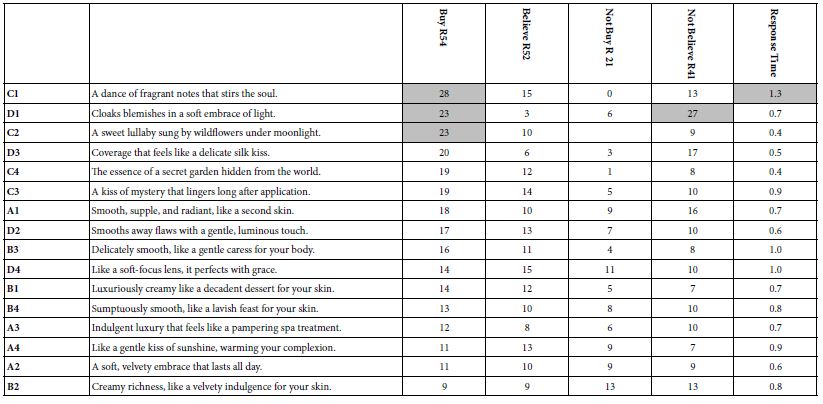
Table 3 shows the coefficients of the five equations for the total panel (Buy, Believe, Not Buy, Not Believe, and Response Time all vs. the presence/absence of the 16 elements).
The results are straightforward to read:
The element performed reasonably well among the total panel. Three elements that performed significantly well specifically for interest in buying:
C1 A dance of fragrant notes that stir the soul.
D1 Cloaks blemishes in a soft embrace of light.
C2 A sweet lullaby sung by wildflowers under moonlight.
D1 is not believed at all, however: this reads “Cloaks blemishes in a soft embrace of light” and calls into question the belief that the product can actually cloak blemishes the way as promised.
Finally, one element truly captures the imagination, as shown by the long response time attributed to that element: 1.3 seconds. The element is: “C1: A dance of fragrant notes that stir the soul.”
If one were to draw any conclusions, one would say that these elements in particular perform very well, but there are no truly strong general patterns.
Moving from the Total Panel to Mind-Sets
The second analysis performed by Mind Genomics groups into clusters based upon the pattern of the 16 coefficients generated by each respondent when the newly created binary dependent variable “buy” (R54 -Buy) becomes the dependent variable. The approach is known as k-means clustering [9].
Each respondent has a distance from every other respondent based on the pattern of the 16 coefficients. The distance is defined by the newly created variable (D = 1- Pearson R). R is the Pearson correlation coefficient. R takes on the value 2 when the correlation R is -1. The lowest possible correlation, -1, corresponds to two people whose 16 elements go in opposite directions and is described by the highest possible distance D between two patterns (D = 2). In contrast, when the two respondents show a perfect linear correlation, +1, the distance is 0 (D 1 – 1 = 0). This is logical because the patterns are parallel to each other, perfectly related. Once we have assigned each respondent to one of the two mind-sets, we revisit the OLS regression and rerun the regression twice, one for Mind-Set 1, and the other for Mind-Set 2.
The story now becomes clearer. Table 4 compares the coefficients for Buy, Believe, and Response Time for Mind-Set 1 vs. Mind-Set 2. Mind-Set 1 comprised 8 of the 25 respondents, while Mind-Set 2 comprised 17 of the 25 respondents. Mind-Set 1 appears to focus on elements presenting information about touch and skin, as well as covering blemishes (elements D1, D2, A1, D3, A4, D4). Mind-Set 1 believes strongly only in one message, D2 (smooths away flaws with a gentle, luminous touch). Mind-Set 1 pays attention to two messages: “Like a gentle kiss of sunshine, warming your complexion,” and “Like a soft focus lens, it perfects with grace.” We might call Mind-Set 1 “Focus on touch and skin.”
Table 4: Coefficients for the 16 elements for Buy, Believe, and Response Time by mind-set. Blank cells correspond to elements with coefficients that are 0 or negative.
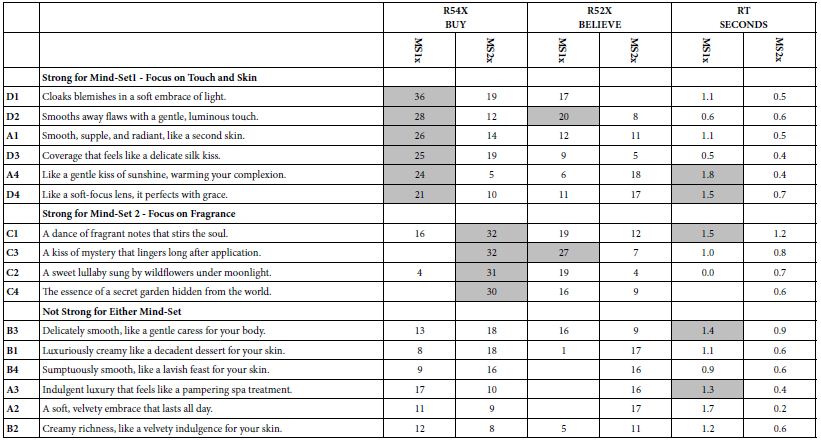
Mind-Set 2 appears to focus on all four elements describing fragrance (C1, C2, C3, C4). However, Mind-Set 2 believes strongly only in one element (a kiss of mystery that lingers long after application). Finally, Mind-Set 2 does not appear to be “captivated” by the phrases because the response times for the elements are all lower than the cut-off point of 1.3 seconds, operationally defined as the level an element has to reach in order to be considered an element that holds the respondent’s attention.
AI Analysis of Strong Performing Elements
With the incorporation of AI into BimiLeap through the Idea Coach feature, the Mind Genomics platform now offers a standardized analysis of strong performing elements, using Chat GPT 3.5. The analysis occurs after the platform has created the full report. The underlying motivation for the analysis is to determine whether AI can pull out additional information about the respondents (viz., Mind-Sets 1 and 2) by further analyzing the strong performing elements.
Table 5 shows the analysis of strong performing elements on the “Buy” scale for Mind-Sets 1 and 2, respectively. Each analysis uses seven queries. The result generates a machine-created interpretation of the data. The important thing here is that Mind Genomics now has a coach that truly provides additional insights. AI now becomes a collaborator with Mind Genomics to add dimensionality and depth to the results describing the attractiveness of the mindset as a target audience, etc.
Table 5: High-level AI analysis of the strong performing element for the question “Buy” (viz. R54), by Mind-Sets 1 and 2.
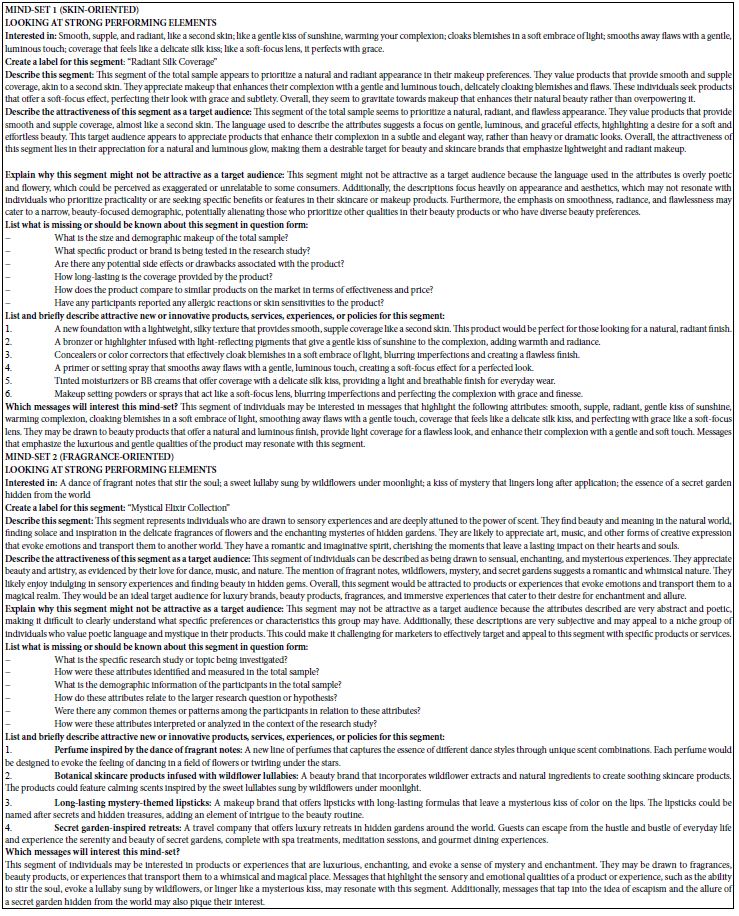
Discussion and Conclusions
The use of AI in market research, particularly in the context of studying consumer responses to new beauty products, may accelerate the way companies gather feedback and make informed business decisions. In this study on the responses to a new skin lotion product among females in the UK ages 18-25, AI played a crucial role in both generating the key elements about the product and running the Mind Genomics experiment. Within just three hours, the three-pronged effort provided insights into how this specific demographic perceived and reacted to the product. One of the major benefits of using AI in this capacity is the speed at which insights can be generated. Traditional market research methods can be time-consuming and costly, but with the help of AI, the researchers were able to collect and analyze data in a fraction of the time. This rapid turnaround time enables companies to make quick adjustments to their marketing strategies and product offerings, keeping them ahead of the competition.
Additionally, AI has the ability to identify patterns and generate hypotheses that may not be immediately apparent to human researchers. By using Mind Genomics analytical capabilities, the study project uncovered two distinct mind-sets among the female participants in our study, providing a deeper understanding of their preferences and behaviors. Overall, the integration of AI and Mind Genomics in market research offers a powerful combination of speed, accuracy, and depth of insights that can be invaluable to companies looking to stay competitive in today’s fast-paced business landscape.
Acknowledgments
The authors gratefully acknowledge the foresight of Dr. Nenad Filipovic to bring this approach of Mind Genomics to Serbia and to encourage its use among students and professionals, as well as to publish the results of papers in the scientific, technical and business literatures. The authors would like to thank Vanessa Marie B. Arcenas and Angela Aton for their ongoing help in preparing this manuscript and its companion papers.
Abbreviations
ChatGPT: Chat Generative Pre-Trained Transformer; OLS: Ordinary Least Squares; RT: Response Time
References
- Beresniak A, de Linares Y, Krueger GG, Talarico S, Tsutani K, et al. (2012) Validation of a new international quality-of-life instrument specific to cosmetics and physical appearance: BeautyQoL questionnaire. Archives of dermatology 148: 1275-1282.
- Eze, UC, Tan CB, Yeo ALY (2012) Purchasing Cosmetic Products: A Preliminary Perspective of Gen-Y. Contemporary Management Research 8: 1.
- Segot-Chicq E, Compan-Zaouati, D, Wolkenstein P, Consoli S, Rodary C, et al, (2007) Development and validation of a questionnaire to evaluate how a cosmetic product for oily skin is able to improve well-being in women. Journal of the European Academy of Dermatology and Venereology: JEADV 21: 1181-1186.
- Gofman A, Moskowitz HR (2012) Rule Developing Experimentation: A Systematic Approach to Understand & Engineer the Consumer Mind (p. 473) Bentham Science Publishers.
- Moskowitz, HR, Gofman A, Beckley J, Ashman H (2006) Founding a New Science: Mind Genomics. Journal of Sensory Studies 21: 266-307.
- Moskowitz H, Rappaport S, Moskowitz D, Porretta S, Velema B, et al. (2017) Product design for bread through mind genomics and cognitive economics. In Developing New Functional Food and Nutraceutical Products (pp. 249-278) Academic Press.
- Moskowitz H, Rappaport S, Wingert S (2024) IDEA COACH: Using Generative AI and Mind Genomics Thinking to Drive Questions and Answers in Industrial Design. In Innovative Industrial Design – Principles and Practices.
- Gofman A, Moskowitz H (2010) Isomorphic permuted experimental designs and their application in conjoint analysis. Journal of Sensory Studies 25: 127-145.
- Likas A, Vlassis N, Verbeek JJ (2003) The Global k-Means Clustering Algorithm. Pattern Recognition 36: 451-461.